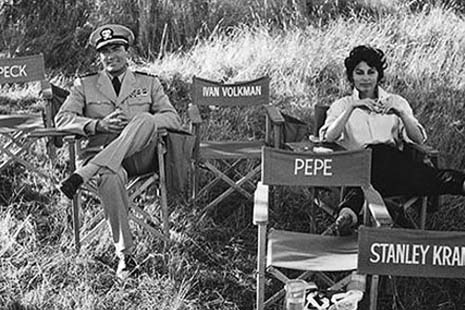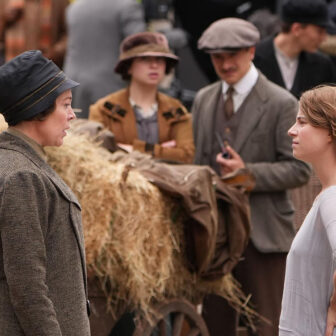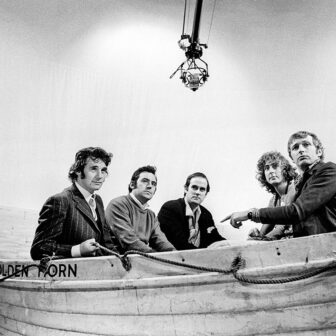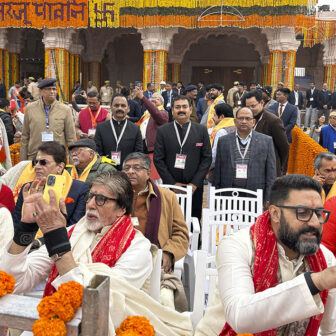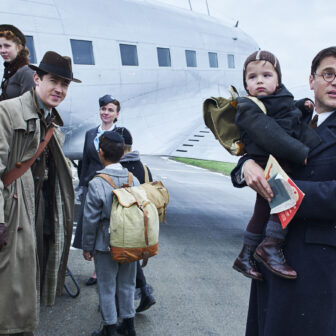LAWRENCE Johnston’s feature documentary Fallout, seen in much-too-limited release, is a most curious shape-shifter. It is dominated by an impassioned anti-nuclear polemic; then, inside the wide historical field marked by the story of the atom bomb and the growth of nuclear armaments, we find an odd piece of film-cultural history, the making of Stanley Kramer’s On the Beach (1959) from Nevil Shute’s novel; and linked to that, we follow a few tracks along the biography of Shute (1899–1960), aeronautical engineer and – almost in spite of himself – highly successful novelist, the Bryce Courtenay of his day. The film begins with a fragmentary quote from John F. Kennedy on the nuclear threat as a Damoclean sword overhanging humanity, and then revives crucial elements of public memory from 1945: the Manhattan Project, the day it was unleashed, the mushroom cloud over Nevada, the terrible glaring light; J. Robert Oppenheimer’s reflection on what he saw as mankind’s newly attained domination of nature. Helen Caldicott appears, reminding us incisively that against the scientists’ calculations, the wind from that first explosion carried malign radiation right across America; we get images of the devastation of Hiroshima and Nagasaki, and the appalling information that the scientists, probing the vast sites of wreckage, sought human bodies not for aid or healing but strictly for research.
The Shute story is carried in archival film and still photographs – most typically showing the writer as aeroplane enthusiast and fast car driver – and by narration and commentary from two experts, Shute’s daughter Heather Mayfield, and the writer Gideon Haigh (whose essay “Shute the Messenger: How the End of the World Came to Melbourne” appeared in the Monthly for June 2007).
We’re told that at the outset, Shute regarded writing as a bit of “a pansy occupation,” but was drawn into it because his adventure stories began selling very well indeed. After settling with his family in Australia after the war, and buying pastoral acres in Gippsland, he lived the writer’s dream – four hours at the desk in the mornings, time outdoors as a gentleman farmer in the afternoons. Several books were filmed; Shute would sell the rights, let the work go, and never give the resulting movie another thought – until it came to Kramer and On the Beach. That one he really cared about, and we’re shown a fragment of an indignant letter to Kramer on the ways in which Shute saw the film as a betrayal. For one thing, it wasn’t his style to suggest that his story’s lovers actually went to bed. In the film’s version, sex is treated quite discreetly, but it’s there. What else would an audience expect, when the stars were Gregory Peck and Ava Gardner? The commentary reminds us that at this time Gardner had just broken up with Frank Sinatra, and thus locates the whole film in the world of stardom and make-believe, playing against the doomsday story of the bomb. Shute’s premise was that after World War Three and all-out destruction, Australia – the further end of the planet – would be the last place to succumb to radiation, and Melbourne the last city to be emptied of population. Lingering sufferers are issued with suicide pills. There’s an image of Bourke Street, emptied, with one stationary tram.
Johnston uses his witnesses brilliantly, Heather Mayfield remembering the adventurous Shute parents with pleasure and humour, and the stunning Karen Kramer, widow of Stanley, bringing old Hollywood glamour to the exercise. Gideon Haigh’s concern is to show how profoundly the nuclear threat took hold of the conservative storyteller, and why – after decades of regarding movie versions with absolute nonchalance – he cared so much about this one, so much angered by its departures from the novel that he refused to attend any of the premieres, which flared across the globe to saturation publicity not long before his death. What the film needed was a clearer framing in Shute’s own story, so that the Manhattan Project and its terrifying consequences can be seen again as that quite unpretentious writer saw them at the time; he wanted readers and viewers to imagine doomsday from here, and to act accordingly.
Film industry veterans, mostly older than Lawrence Johnston, will see some of their own political history in this film. Here we are, back then, with Australia as a location, Australian actors and film workers in smaller parts, audiences and public only too ignominiously grateful. Here was the full Hollywood caravan, Peck and Gardner and Fred Astaire and Anthony Perkins all in top billing, and the wonderful John Meillon, Harp McGuire, Lola Brooks and Guy Doleman in credited bit parts, and Peter O’Shaughnessy and Graham Kennedy, no less, in the uncredited list. It all happened again the next year, with Fred Zinnemann’s The Sundowners, from the Jon Cleary novel; there Robert Mitchum, Deborah Kerr and Glynis Johns tried for Australian accents, Chips Rafferty had a decent stereotypical role, and an Australian, Lex Halliday, got to be second-unit director. Those who were properly angered by our cultural-colonial status were incited into a long campaign, and in time they won. In certain contexts, cultural nationalism was and is forgivable.
WARWICK Thornton’s compilation of ghost stories, The Darkside, has attracted very small audiences, and a good deal of hostile comment for the way it gives room to the Aboriginal religious domain. Some of that surprised me; do honest Western secularists and atheists need, at this point in history, to hold others’ mythologies in contempt? People are haunted; rewrite their hauntings as memory or trauma, as you will. Deborah Mailman sits on a verandah, retailing the evil apparently done to her family by a wandering ouija board; Marcia Langton is there in a background corner, out of focus but unmistakable, playing solitaire and casting stern, intolerant glances at Mailman as she speaks. The camera is dead still, the point of view holding steady as in almost every other sequence in the film. There is space to credit the characters, and space also to doubt their ways of understanding. A Thursday Island woman, who insists that she is a Christian, tells us how she ejected a wandering demon. An unseen man tells us how he experienced an eclipse of the sun; all we see in this one is a black circle on a white ground. Jack Charles – swigging beer as he goes, sitting at a bar in garish yellow light – recounts an episode on a haunted hill; Bryan Brown, as a white man cruising a billabong, tells of seeing a vivid young, female Aboriginal ghost who – just to complicate things further – was wearing a very clean, patterned contemporary dress. At the end a young woman (Shari Sebbens) goes through the story of an infant niece’s few precarious months of life, her death and its link to that of a departed grandmother. For the girl, the grandmother is an indisputable presence as the baby dies; with her, the young aunt makes bearable sense of what’s both senseless and unbearable.
As another white character, Claudia Karvan dreams and hallucinates her way into a spectacular Aboriginal fire dance; emerging, she says she feels greatly honoured to have been received into another way of being. In the most complex sequence, Romaine Moreton takes us into the depths of the National Film and Sound Archive to look at early twentieth-century anthropological film on Aborigines, viewed at the time as possible specimens of the mythic missing link; she recounts her shock, and the way her research path diverged to follow tracks she hadn’t foreseen. There is no intimation here of after-life or invisible dimensions; Morton’s ghosts are precisely history, filmed history. We don’t see her; she is the guiding voice.
Neither she nor the others invite identification or empathy. Thornton is using a quasi-Brechtian kind of modernism to take us to a blurred, fractured kind of boundary. Aboriginal thinking and feeling reach to its further side, which the storytellers apprehend if we do not; we follow them in their states of belief. Those states are not for sharing, but for watching, for learning something more about cultural difference and distance.
Writing of these two films, I am aware of advancing the claims of work you mightn’t be able to see, on the big screen at least; if this seems unfair in one way, it also matters to speak about just those films which haven’t been promoted on the circuits, but should be better known. The Darkside especially goes to meet a cinematically sophisticated audience; they ought to know it’s there.
OLIVIER Assayas’s After May (also named Something in the Air) has been found enjoyable for its wildly energetic transmission of youth on the rampage in post-’68 Paris, where the immediate inheritors of the legendary insurrection are seen jumping around, trying to revive its spirit, and especially to make guerilla war, through sloganeering and firebombs, on the police (de Gaulle, for some reason, isn’t mentioned). There is a large cast, mostly of the beautiful and young, in seventies gear that hasn’t really gone out of date, a seductive musical lineup, and intermittent news footage of real struggles in China and Laos; but it’s a long two hours, mainly because the director doesn’t seem to have any more idea than do his characters of where you can go from privileged, individualistic urban rebellion. I’ve been as romantic as any other fellow-travelling Australian veteran about May ’68; but nostalgia is out of order, if indeed it was ever in. What matters is to remember how the upsurge unblocked flows of energy in ways the exuberant students couldn’t have predicted; what the links were with the factory outbreaks and really important strikes; what kind of difference was made to France, politically and industrially. It was delivered a timely shock; and then Gaullism returned, resoundingly, and it matters now to remember too what that time meant elsewhere in Europe, in Prague and Budapest, and what kinds of repression the liberationist movements were calling down on their leaders’ heads. Blithely indifferent to all this, Assayas’s pretty exercise is a bad film in one important way: by default at least, it’s lying. •
Sylvia Lawson’s Demanding the Impossible: Essays on Resistance is published by Melbourne University Publishing.
